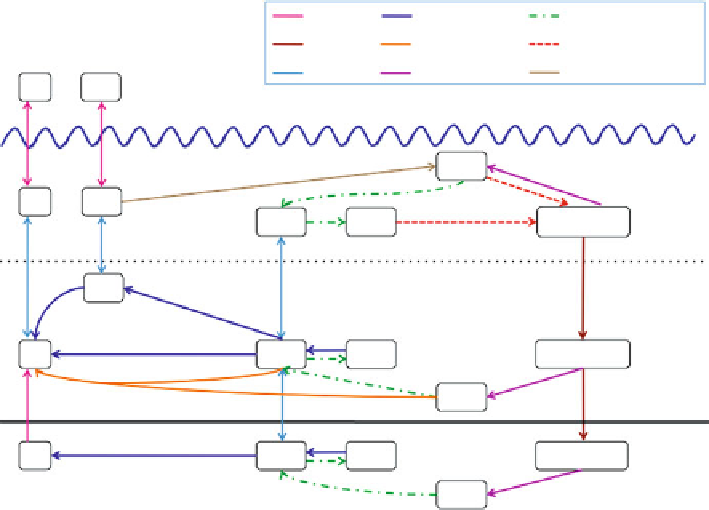Environmental Engineering Reference
In-Depth Information
Diffusion
Sinking
Mixing
Denitrification
Nitrification Nitrogen
Assimilation
Nitrogen Fixation
Annamox
Ammonification
N
2
N
2
O
NH
4
+
N
2
N
2
O
NO
2
−
NO
3
−
Organic N
Euphotic
Zone
Aphotic
Zone
N
2
O
N
2
NO
2
−
NO
3
−
Organic N
NH
4
+
Sediment
N
2
NO
2
−
NO
3
−
Organic N
NH
4
+
Fig. 12.3 Schematic of the nitrogen cycle showing the nine key mechanisms by which nitrogen
moves through the water column, which are denitrification (
dark blue line
), nitrification (
green
dash-dot line
), nitrogen assimilation (
red dashed line
), nitrogen fixation (
brown line
), ammonifi-
cation (
purple line
), annamox (
orange line
), mixing (
light blue line
), diffusion (
pink line
), and
sinking (maroon line)
depend on the distribution of heterotrophs, such as copepods, which is variable.
Nitrification is the production of
NO
3
from ammonium. Earlier work suggested
that this was a relatively slow process, but more recent investigations suggest that
the oxidation of
NH
4
and production of nitrate is quite rapid, particularly in tropical
waters.
The different transformations result from different organisms and some require
specific types of environmental conditions (
Table 12.1
). Denitrification and nitro-
gen fixation are anaerobic processes, which occur only in the absence of oxygen.
Oceanic systems, ranging from estuarine to open ocean, provide sites for denitrifi-
cation and as a result are depleted of oxygen. These oxygen-minimum regions are
characterized by large vertical fluxes of organic matter, which heterotrophic bacte-
ria oxidize and release nitrogen, consuming the available oxygen in the process.
Anoxic conditions also occur in sediments where oxygen is depleted by aerobic
metabolism. An unusual biological adaptation allows for nitrogen fixation (an
anaerobic process) to occur in surface waters with high levels of oxygen. Some
organisms (e.g., the cyanobacterium
Trichodesmium)
form extensive patches or
tufts. These tufts, by virtue of their own metabolism, unusually thick cell walls and
biochemical modifications of specialized cells where N
2
fixation occurs, create

